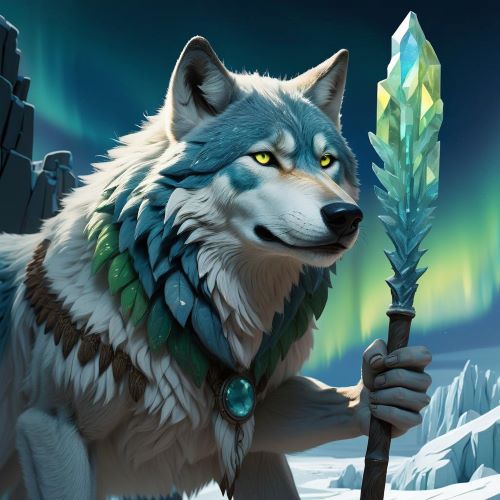Sedna : Goddess of the Sea
Listen
At a glance
| Description | |
|---|---|
| Origin | Inuit Mythology |
| Classification | Gods |
| Family Members | Anguta (Father), Isarrataitsoq (Mother) |
| Region | Canada, Greenland, Alaska |
| Associated With | Sea, Marine Life |
Sedna
Introduction
Sedna, a central deity in Inuit mythology, is deeply associated with the sea and marine life. Revered as the goddess of the ocean, she plays a pivotal role in Inuit folklore and serves as a symbol of respect for the sea and its creatures. Sedna’s myth is integral to understanding Inuit culture, reflecting a profound relationship with the natural world. Known also as the Mother or Mistress of the Sea, she is a figure of both awe and reverence. Her legend, a foundational creation story, narrates her ascent to ruling Adlivun, the Inuit underworld, and her dominion over oceanic creatures.
Sedna’s mythology intertwines with the Inuit’s cultural values, illustrating themes of survival, nature, and human resilience. Her role extends beyond ancient tales, influencing contemporary Inuit art, literature, and social practices. Through her story, Sedna embodies a deep connection to marine life and underscores the importance of reciprocity and respect within the Arctic environment.
Across various Inuit communities, Sedna is depicted as a powerful entity governing sea creatures and, by extension, the hunters who depend on them. Her myths emphasize her complex nature, encompassing themes of loss, betrayal, and endurance. Sedna’s legacy offers a lens into Inuit values, reflecting a nuanced understanding of the delicate balance between humans and nature. As both a cultural icon and a significant spiritual figure, Sedna continues to shape Inuit identity and worldview.
Physical Traits
Sedna’s appearance in Inuit mythology is marked by a unique and evocative duality. She is often visualized with a human upper body and a lower half that resembles a seal, symbolizing her profound link to both terrestrial and marine realms. This imagery reflects her essential nature as a bridge between the land and the sea. Traditional Inuit art frequently depicts her with flowing hair, sometimes interpreted as kelp or seaweed, enhancing her connection to oceanic life.
In some versions of her story, Sedna’s fingers are depicted as severed, symbolizing the pain and sacrifices she endured. This dramatic transformation underscores her suffering and the betrayal she faced, reinforcing her role as a powerful figure linked to the ocean’s depths. These severed fingers are believed to have given rise to marine creatures like seals, walruses, and whales, further intertwining her essence with the sea. Sedna’s physical form serves as a poignant reminder of the harsh realities of survival in the Arctic, embodying the interplay between human suffering and the natural world.
Family
Sedna’s familial background is central to her myth, highlighting themes of betrayal and transformation. She is often described as the daughter of a powerful sea deity or a reclusive figure, residing in isolation with her family. Her story frequently begins with her marriage to a sea creature, marking her transition from a terrestrial life to a deeper connection with the ocean.
The dynamics within her family underscore the myth’s focus on emotional turmoil. Sedna’s father, angered by her marriage, plays a crucial role in her fate. In many versions of the story, after her husband reverts to his sea creature form and she is cast out, her father’s rejection forces her into the ocean. This abandonment leads to her transformation into a sea goddess, where she gains dominion over marine life. Variations of the myth include different parental figures; in some stories, she is the daughter of Anguta, a creator god, while in others, her mother is a goddess named Isarrataitsoq. Additionally, some versions feature her marrying a dog, further complicating her familial relations and her eventual role as a sea deity.
Other names
Sedna is recognized by various names across Inuit cultures, each reflecting different aspects of her character and significance. Among these names are “Nuliajuk,” “Nerrivik,” and “Sassuma Arnaa,” the latter translating to “Mother of the Deep” in West Greenlandic. These titles emphasize her central role in the marine world and highlight her reverence across different Inuit communities.
The diversity in her names illustrates how her myth has adapted to various regional contexts, capturing local interpretations and cultural values. For instance, in the Coronation Gulf area, she is referred to as Arnapkapfaaluk, meaning “Big Bad Woman,” while in Killiniq, Labrador, she is known as “Old-woman-who-lived-in-the-sea.” These variations reflect the broad influence of Sedna’s legend and its integration into local narratives about the sea, sustainability, and human-nature harmony.
Powers and Abilities
As the goddess of the sea, Sedna commands significant influence over the marine environment. She oversees all sea creatures and acts as an intermediary between humans and the ocean. Her ability to provide or withhold essential sea animals reflects the Inuit’s belief in a reciprocal relationship with nature. To ensure their survival, Inuit people perform rituals and offer sacrifices to gain her favor.
Sedna’s powers also include controlling weather and sea conditions, making her a crucial figure in managing the Arctic’s harsh climate. Her abilities extend beyond environmental control to embody resilience and retribution. When disrespected or mistreated, she can summon storms and disasters as a form of punishment, illustrating her capacity to enforce the balance of nature.
Inuit beliefs also tie Sedna to the enforcement of taboos related to hunting and sea practices. Violations, such as hunting out of season or showing disrespect, can provoke her anger, leading to scarcity and hardship. To appease her, shamans perform spiritual journeys to the underwater realm, where they engage in rituals such as combing Sedna’s hair, a task she cannot perform due to her severed fingers. This act symbolizes an effort to restore harmony and ensure continued access to vital sea resources.
Modern Day Influence
In modern times, Sedna remains a potent symbol within Inuit culture, reflecting themes of survival, identity, and environmental awareness. Contemporary Inuit artists and writers have reimagined her figure, blending traditional aspects with modern perspectives to address current issues and cultural narratives.
Sedna’s relevance extends beyond Inuit communities into broader discussions on indigenous rights, environmental protection, and cultural preservation. Her story is frequently invoked in debates about climate change and its effects on the Arctic, representing the fragile balance between humanity and the environment.
Cultural revival efforts have reintegrated Sedna’s mythology into educational settings and community activities, enhancing appreciation for traditional values and knowledge. Her narrative now serves not only as a cultural touchstone but also as a symbol of resilience and environmental stewardship in the face of changing climatic conditions.
Sedna’s legacy also influences global culture, appearing in various forms including literature, art, and even astronomy. For example, a distant dwarf planet discovered in 2003 was named Sedna, honoring her association with the enigmatic depths of the ocean. Through these diverse representations, Sedna’s myth continues to underscore the importance of respecting and preserving the natural world.
Related Images
Frequently Asked Questions
What is lorem Ipsum?
I am text block. Click edit button to change this text. Lorem ipsum dolor sit amet, consectetur adipiscing elit. Ut elit tellus, luctus nec ullamcorper mattis, pulvinar dapibus leo.
What is lorem Ipsum?
I am text block. Click edit button to change this text. Lorem ipsum dolor sit amet, consectetur adipiscing elit. Ut elit tellus, luctus nec ullamcorper mattis, pulvinar dapibus leo.
What is lorem Ipsum?
I am text block. Click edit button to change this text. Lorem ipsum dolor sit amet, consectetur adipiscing elit. Ut elit tellus, luctus nec ullamcorper mattis, pulvinar dapibus leo.
What is lorem Ipsum?
I am text block. Click edit button to change this text. Lorem ipsum dolor sit amet, consectetur adipiscing elit. Ut elit tellus, luctus nec ullamcorper mattis, pulvinar dapibus leo.
What is lorem Ipsum?
I am text block. Click edit button to change this text. Lorem ipsum dolor sit amet, consectetur adipiscing elit. Ut elit tellus, luctus nec ullamcorper mattis, pulvinar dapibus leo.











